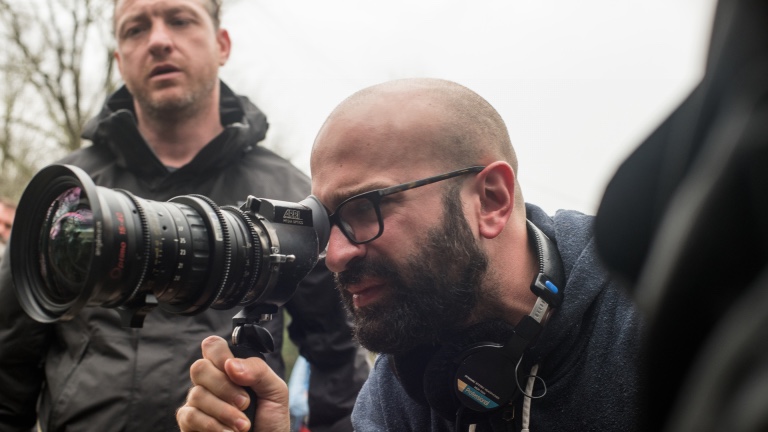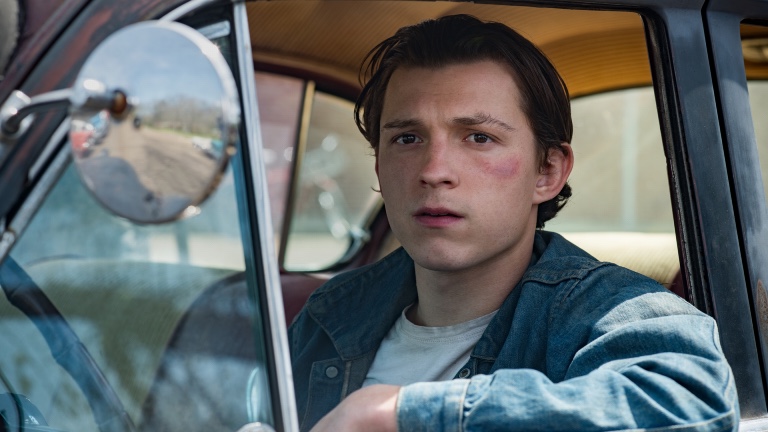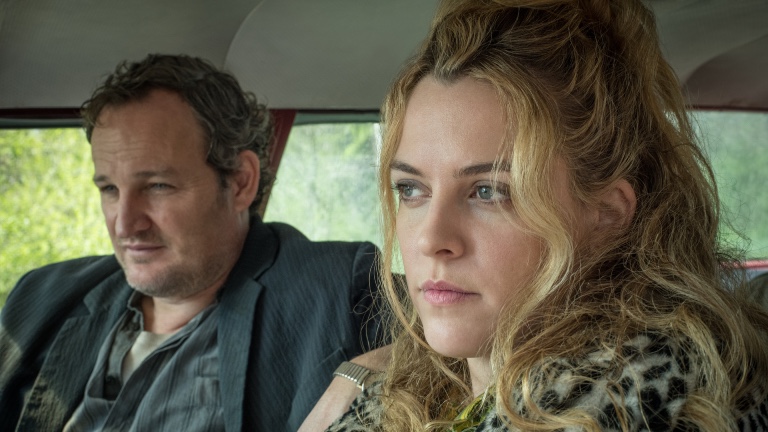Filmmaker Antonio Campos didn’t actually burst onto the indie movie scene with his first couple movies, Buy It Now (2005) and Afterschool (2008), but it paved the way for his work with Borderline Productions and fellow filmmakers Sean Durkin (Martha Marcy May Marlene), Josh Mond (James White), Nicolas Pesce (The Eyes of My Mother) and even Brady Corbet (Vox Lux), who co-wrote and starred in Campos’ third film, Simon Killer.
With The Devil All the Time, Campos takes a fairly large leap, not only working directly with a studio – in this case, Netflix — but also adapting a difficult and layered novel by Donald Ray Pollock, with his first-time screenwriter brother Paulo Campos, no less.
Based on Donald Ray Pollock’s novel, the movie is a cmplex multi-narrational tale of the residents of a community in and around Knockemstiff, Ohio, taking place in between WWII and the Vietnam War, as it follows two generations of men who have to deal with the likes of religious zealots, serial killers and a crooked sheriff. Mostly, it follows young Arvin Russell, played by Tom Holland, as he navigates his way through these characters while trying to protect his half-sister Lenora (Eliza Scanlen) from the likes of Preston Tegardin (Robert Pattinson), the town’s new preacher who preys on young girls. Campos’ illustrious cast also includes Jason Clarke, Riley Keough, Sebastian Stan, Bill Skarsgård, Mia Wasikowska, Haley Bennett and more.
Below the Line spoke with Campos a few weeks back at the film’s virtual junket, also talking about working with Cinematographer Lol Crawley and the film’s editor, Sofía Subercaseaux, who also happens to be Campos’ wife.

Below the Line: How did you find Don Pollock’s book and what jumped out at you?
Antonio Campos: This was a book that was given to me by Randall Poster, who’s known as a music supervisor and is a producer on this movie. He gave me the book to say, “Look, I really love this book. I think you’ll really love it, and if you love it, let’s try and make a movie out of it,” and that’s what we did. I really loved the book, and the thing that jumped out at me about the book was that Don Pollock’s writing is incredibly cinematic and visual. That immediately caught me and then beyond that, there was just specific visuals I saw, images, locations, places in the book that I was excited to try and create on screen, like the prayer log was a thing that I wanted to see that on screen. I want to be part of creating that place. I want to find the log. I want to see what that cross that Willard makes looks like. I was also really drawn to this element of the Carl and Sandy storyline, which involves photography, and I thought there was a way to capture what they did as serial killers that hadn’t been done before where we didn’t have to be super-explicit with it, but that we could create this sense that there was this breath of the killing this guy had done, that they had done together, just through still images. I thought that was a really cool way into that. It was just a lot of stuff like that, or even a line as simple as, “It’s a prayer log but it don’t work too good.” I just thought that was such a great line, and I wanted to hear someone say that line. All these things added up, and the book is just that kind of wonderful read. I just felt like I wanted to see this movie.
BTL: Was this the first time writing with your brother or have you worked together before?
Campos: No, we had never written together before. My brother writes prose – he’s never written a script until this, and he and I were just really connected about these genres. He’s my older brother, so a lot of the stuff that he liked, he turned me on to, so that’s why there’s a connection. Flannery O’Connor is a writer that we both loved, and Jim Thompson’s a writer that we both loved, so that’s Southern Gothic and hardboiled noir fiction. We just kind of both loved the genres that play and connect to the generational story.

BTL: I spoke with Lol Crawley, your DP, about the locations and what’s involved with shooting so much outdoors. What was involved with finding these places and where did you end up going? Were you able to do that while you were still in the script stage to see where you might want to make the movie?
Campos: Well, we had been scouting Southern Ohio as a place to shoot and West Virginia, Northern Kentucky to double as West Virginia, and then because of an actor’s schedule, we had to move South. We started shooting in February, instead of March or April so we had to all of a sudden pivot to Northern Alabama, which was different. What we did was we found terrain and places that really felt like Southern Ohio. That’s why we chose Northern Alabama, because it feels like Appalachia. The Appalachian trail touches it, and Northern Alabama is mining country like Southern Ohio, like West Virginia. There’s a lot of intersection there. No, we didn’t have the luxury of having the locations that we had been thinking about during script phase, because we went from one state to another. Lol, the production designer, and I were dead set on finding the perfect location for every place, so we went deep into the woods. I got bitten by ticks a couple times. We drove hours and hours and hours and got lost and went down every road, followed every little breadcrumb to try and find the locations we needed.
BTL: This was also the first time you’d worked with Lol. You’ve made four movies that all look pretty amazing, so are you trying to work with different cinematographers to make sure each movie looks different than the last one?
Campos: There’s no sort of rule about who I work with from one film to the next — sometimes, it’s a scheduling thing. In the case of Lol, specifically, I mean, Lol is an artist, and just this amazing energy to have on set. What I love about Lol is that he loves to prepare — he’s very methodical. We shot-listed the entire movie, but at the same time, he’s very nimble and flexible and can shift gears and [he’s] open to what comes from the actors, what comes from the environment that we didn’t expect. He’s also just a master of light and a master of celluloid, and I really needed somebody who had that confidence to work 35mm, which you know, is hard to come by. Lol is just a Master of 35. He shoots so much, and he really knows how far he can push it.
BTL: I also wanted to talk about working with the producers and casting director to put together this huge cast. It’s a little surprising how late before Tom Holland and Robert Pattinson show up in the movie. Can you talk about how you put this cast together?
Campos: With a film like this where it’s such a true ensemble, it takes time to find the right actors for all the different roles. Sometimes, it’s just kind of good fortune that you happen to work with someone that you really like. In the case of Mia [Wasikowska], I had worked with her as a producer in a movie she was in, and we got along really well. She responded to the role, or in the case of Rob, I just happened to get to know him through some mutual friends. When I showed him an early draft of the script, he really responded to Teagarden and wanted to play that guy, so that was very fortunate. He had just come off of Good Time, and then there’s just really good old-fashioned auditioning. I work with a great casting director named Doug Aibel. He’s a New York theater guy, and we’re looking at people that are in film and television and people that are very accomplished theater actors. Then there’s also a very amazing local casting person in the South named Tracy Kilpatrick that I’ve worked with a few times on The Sinner and on Christine, and we just looked for really interesting, unknown actors, that are just acting in the South. There’s so much production production down there that there’s just like a whole circuit of actors down there. It’s just a really long, methodical process, and you just want to make sure that you’re putting together an ensemble that that all makes sense at the end of the day.

BTL: I was surprised to see Jake Gyllenhaal’s name on as a producer, but he didn’t actually take one of the roles he could have played. Was that just a timing or scheduling issue?
Campos: Jake was always just a producer on this. The connection to Jake came through Riva Marker. I had gotten to know Riva a little bit just through a general meeting, and when we were looking for a partner on this, it just felt like a good fit. Through Riva obviously, I met Jake, ‘cause they run Nine Stories [Productions] together. Jake was just very supportive throughout and he got behind the film in a meaningful way. It was never like, “Hey, man, do you want to be in the movie?” He was a producer on the project, and that was really nice.
BTL: I also didn’t realize you were married to your editor, which could be a luxury. It could also be a case where you’re seeing each other 24 hours a day, which you might normally be doing with an editor anyway. I assume she’s involved very early on in the script stage?
Campos: She’s reading drafts, and she’s listening to me wrestle with different ideas and try and figure out how to solve problems. From day one of shooting, she’s assembling, and in this case, she was also breastfeeding, so she was like editing the first part of the day, and she had to run back and forth. It was just a very intense process, and she’s my partner from before the film is made until the very last day when we mix and color-correct the movie. She’s my closest collaborator.
BTL: I haven’t read the book, but I read the Cliff Notes version on Wikipedia, and I definitely noticed that the events in the book are told in a different order, so did things change in the editing phase as far as where events take place vs. your original adaptation?
Campos: The script just had to be inherently different than the book. It was just an organic process. We really focused on trying to capture the essence of every story and every character, and always kept in mind, the big Willard and Arvin narrative that tied the whole movie together. That was the key. We knew we had to cut a lot out of the book, but we had to really sort of see. If you really had to take the book apart and distill it to the pieces; that’s what the movie was. The biggest stamp of approval that we have is that the author is not only a fan, he’s the voice over in the movies. The thing that Don said to Paulo and I that really moved us was that we captured the spirit of the book. That was always our intent to be faithful, to do justice to the great work that Don did in his book and the complexity of it.
BTL: Lol mentioned that the movie is going to play in some theaters, so have you had a chance to see the movie in a theater before they got shut down?
Campos: I haven’t had the chance to see it in a theater except for the color correct and the sound mix and stuff like that. I won’t be able to see it in the theater this year. I think next year, hopefully I’ll be able to sit down with an audience somewhere and see it.
The Devil All the Time will be streaming on Netflix starting Wednesday, September 16, and will also apparently open in a few scattered theaters across the country. Look for our interview with Cinematographer Lol Crawley later this week.





